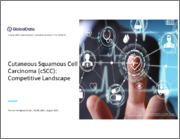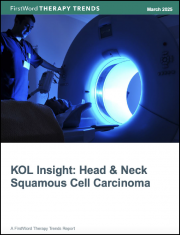
|
시장보고서
상품코드
1354501
세계의 편평상피암(cSCC) 시장 : 시판 중인 의약품 및 파이프라인 의약품 평가, 임상시험, 경쟁 구도Cutaneous Squamous Cell Carcinoma (cSCC) Marketed and Pipeline Drugs Assessment, Clinical Trials and Competitive Landscape |
||||||
이 보고서는 세계 편평상피암(cSCC, Cutaneous Squamous Cell Carcinoma) 시장을 조사 분석하여 질병 현황, 시판 중인 의약품 및 파이프라인 의약품 평가, 현재와 미래경쟁 구도 등의 정보를 제공합니다.
목차
제1장 서문
제2장 주요 조사 결과
제3장 질환 상황
- 질환 개요
- 역학 개요
- 치료 개요
제4장 출시 의약품 평가
- 주요 출시 의약품
- 개요 : 작용기전별
- 개요 : 투여 경로별
- 출시 의약품 개요와 판매 예측
제5장 가격 결정과 상환 평가
- 연간 치료비
- 가격 결정과 상환까지 시간
제6장 파이프라인 의약품 평가
- 3상 파이프라인 의약품
- 개요 : 개발 단계별
- 개요 : 분자 유형별
- 개요 : 작용기전별
- 개요 : 투여 경로별
- 약품 고유 단계 이동 성공률(PTSR)과 승인 가능성(LoA)
- 치료 영역과 적응증 고유 PTSR과 LoA
제7장 임상시험 평가
- 과거 개요
- 개요 : 단계별
- 개요 : 현황별
- 개요 : 진행중·계획중인 임상시험 단계별
- 가상 컴포넌트를 사용한 시험
- 지리적 개요
- 단일국·다국간 시험 : 지역별
- 내역 : 주요 20개 스폰서와 단계별
- 내역 : 주요 20개 스폰서 현황별
- 개요 : 엔드포인트 현황별
- 개요 : 인종 및 민족별
- 등록 데이터
- 시험 시설 상위 20개국
- 세계의 상위 20개 시설
- 실현 가능성 분석 - 지리적 개요
- 실현 가능성 분석 - 벤치마크 모델
제8장 거래 상황
- 합병, 인수, 전략적 제휴 : 지역별
- 최근의 합병, 인수, 전략적 제휴
제9장 상업적 평가
- 주요 시장 기업
제10장 향후의 시장 촉매
제11장 부록
LSH 23.10.11Abstract
Squamous cell carcinoma (SCC) of the skin is known as cSCC. Adding the word "cutaneous" identifies it as a skin cancer and differentiates it from squamous cell cancers that can arise inside the body, in places such as the mouth, throat, or lungs. cSCC is the second-most common nonmelanoma skin cancer after basal cell carcinoma (BCC).
The Cutaneous Squamous Cell Carcinoma (cSCC) marketed and pipeline drugs market research report includes an assessment of the disease epidemiology, leading marketed products with sales forecast, pricing and reimbursement, and late-to-mid-stage pipeline products with Phase Transition Success Rate (PTSR), and Likelihood of Approval (LoA) for Cutaneous Squamous Cell Carcinoma (cSCC). The report also analyzes the clinical and commercial landscapes of cSCC drugs, as well as an assessment of deals, future market catalysts, key market players, and the future competitive environment.
Scope
GlobalData's cSCC: Competitive Landscape combines data from the Pharma Intelligence Center with in-house analyst expertise to provide a competitive assessment of the disease marketplace.
Components of the report include -
- Disease Landscape
- Disease Overview
- Epidemiology Overview
- Treatment Overview
- Marketed Products Assessment
- Breakdown by Mechanism of Action, Route of Administration
- Product Profiles with Sales Forecast
- Pricing and Reimbursement Assessment
- Annual Therapy Cost
- Time to Pricing and Time to Reimbursement
- Pipeline Assessment
- Breakdown by Development Stage, Mechanism of Action, Molecule Type, Route of Administration
- Product Profiles with Sales Forecast
- Late-to-mid-stage Pipeline Drugs
- Phase Transition Success Rate and Likelihood of Approval
- Clinical Trials Assessment
- Breakdown of Trials by Phase, Status, Virtual Components, Sponsors, Geography, and Endpoint Status
- Enrolment Analytics, Site Analytics, Feasibility Analysis
- Deals Landscape
- Mergers, Acquisitions, and Strategic Alliances by Region
- Overview of Recent Deals
- Commercial Assessment
- Key Market Players
- Future Market Catalysts
Reasons to Buy
- Develop and design your in-licensing and out-licensing strategies through a review of pipeline products and technologies, and by identifying the companies with the most robust pipeline.
- Develop business strategies by understanding the trends shaping and driving the cSCC market.
- Drive revenues by understanding the key trends, innovative products and technologies, market segments, and companies likely to impact the global cSCC market in the future.
- Formulate effective sales and marketing strategies by understanding the competitive landscape and by analyzing the performance of various competitors.
- Identify emerging players with potentially strong product portfolios and create effective counter-strategies to gain a competitive advantage.
- Organize your sales and marketing efforts by identifying the market categories and segments that present maximum opportunities for consolidations, investments, and strategic partnerships.
Table of Contents
Table of Contents
1 Preface
- 1.1 Contents
- 1.2 Report Scope
- 1.3 List of Tables and Figures
- 1.4 Abbreviations
2 Key Findings
3 Disease Landscape
- 3.1 Disease Overview
- 3.2 Epidemiology Overview
- 3.3 Treatment Overview
4 Marketed Drugs Assessment
- 4.1 Leading Marketed Drugs
- 4.2 Overview by Mechanism of Action
- 4.3 Overview by Route of Administration
- 4.4 Marketed Drugs Profiles and Sales Forecasts
5 Pricing and Reimbursement Assessment
- 5.1 Annual Therapy Cost
- 5.2 Time to Pricing and Reimbursement
6 Pipeline Drugs Assessment
- 6.1 Phase III Pipeline Drugs
- 6.2 Overview by Development Stage
- 6.3 Overview by Molecule Type
- 6.4 Overview by Mechanism of Action
- 6.5 Overview by Route of Administration
- 6.6 Drug Specific Phase Transition Success Rate (PTSR) and Likelihood of Approval (LoA)
- 6.7 Therapy Area and Indication-specific PTSR and LoA
7 Clinical Trials Assessment
- 7.1 Historical Overview
- 7.2 Overview by Phase
- 7.3 Overview by Status
- 7.4 Overview by Phase for Ongoing and Planned Trials
- 7.5 Trials with Virtual Components
- 7.6 Geographic Overview
- 7.7 Single-Country and Multinational Trials by Region
- 7.8 Top 20 Sponsors with Breakdown by Phase
- 7.9 Top 20 Sponsors with Breakdown by Status
- 7.10 Overview by Endpoint Status
- 7.11 Overview by Race and Ethnicity
- 7.12 Enrollment Data
- 7.13 Top 20 countries for Trial Sites
- 7.14 Top 20 Sites Globally
- 7.15 Feasibility Analysis - Geographic Overview
- 7.16 Feasibility Analysis - Benchmark Models
8 Deals Landscape
- 8.1 Mergers, Acquisitions, and Strategic Alliances by Region
- 8.2 Recent Mergers, Acquisitions, and Strategic Alliances
9 Commercial Assessment
- 9.1 Key Market Players
10 Future Market Catalysts
11 Appendix
- 11.1 Methodology
- 11.2 Methodology - Sales Forecast
- 11.3 Methodology - Pricing and Reimbursement
- 11.4 Methodology - PTSR and LoA Analysis
- 11.5 About the Authors
- 11.6 Contact Us
- 11.7 Disclaimer

















